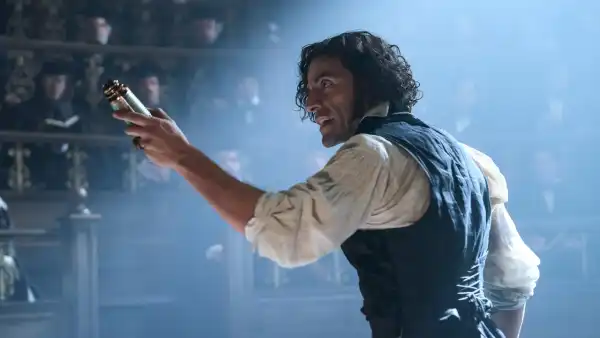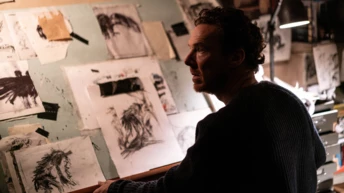
Save this storySave this storySave this storySave this story
Earlier in the year, when Quentin Tarantino was prompted to analyze the highlights of his film work in an interview, he characterized the “Kill Bill” diptych (2003-04) as “the motion picture I was destined to create.” He continued, “I consider ‘Inglourious Basterds’ my greatest accomplishment, but ‘Once Upon a Time . . . in Hollywood’ is my personal favorite.” Could these be distinctions without real significance? I tend to be skeptical of narratives about artistic predestination, particularly because a filmmaker possessing noteworthy talent, consistent vision, and propitious circumstances could easily accumulate several possible contenders for the title. Consider Ryan Coogler, who has employed the “destined to create” phrase to describe both his initial feature, “Fruitvale Station” (2013), and his most recent, “Sinners” (2025)—his sole two films, it should be noted, that aren’t parts of a studio series.
Nevertheless, regarding the upcoming “Frankenstein,” which marks the thirteenth feature helmed by Guillermo del Toro—and is, according to nearly everyone, the picture he was fated to make—the commonplace idea merits closer examination than a swift dismissal. This represents del Toro’s unique Holy Cinematic Quest, one he has pursued, if not since birth, then certainly from the instant he first gazed, captivated, at James Whale’s celebrated “Frankenstein,” from 1931. At that juncture, del Toro was seven years old, raised in Guadalajara, Mexico. At eleven, he perused Mary Shelley’s 1818 novel, “Frankenstein; or, the Modern Prometheus.” His productions, which have established him as Hollywood’s foremost contemporary purveyor of horror-fantasy, are pervaded by Frankensteinian motivations. No director demonstrates a stronger allegiance to the humanity inherent in the monster and the monstrosity present in humans. Within “The Shape of Water” (2017), we champion a scaly amphibious mutant while relishing the downfall of his tormentor. In “Nightmare Alley” (2021), which immerses us amidst the deformed inhabitants of a travelling show, an attractive, suave charmer is the only genuine oddity in sight. The remarkable “Pan’s Labyrinth” (2006)—speaking of a movie del Toro was destined to make—offers tribute to one of the most subtly Frankensteinian movies, Victor Eríce’s “The Spirit of the Beehive” (1973). Within that radiant classic, a six-year-old girl, having viewed the 1931 film, believes the monster to be entirely, terrifyingly authentic. She and the young Guillermo, who reached nine the year Eríce’s film was released, were kindred spirits.
Regardless, del Toro has not simply concocted another Whale-like story. For one instance, his “Frankenstein,” which is currently playing in certain theatres and will commence streaming November 7th, on Netflix, clocks in at two hours and twenty-nine minutes—sufficient duration to experience the 1931 film twice and replenish a popcorn container in the intervening period. Furthermore, the Creature is portrayed by Jacob Elordi, who, akin to the majority of performers who have convincingly embodied Elvis Presley, bears little resemblance to the Boris Karloff of his era. The Creature, frequently presented as a less-than-cheery green giant, is now a fascinating exploration in sentient marble—a towering, graceful, ivory-hued entity, his head hairless (initially), his face and physique adorned with stretches of somber blue, and his groin area, though presumably as reanimated as the remainder of him, kept discreetly obscured.
The initial instance we observe the Creature, however, we perceive hardly any of him whatsoever: he exists as a featureless phantom, concealed in a dark cloak and consumed by a vengeful disposition, relentlessly pursuing his originator, Baron Victor Frankenstein (Oscar Isaac). The year is 1857, and our location is somewhere within the Arctic. A vessel, headed for the North Pole, finds itself entrapped in ice, and its marooned mariners, commanded by Captain Anderson (Lars Mikkelsen), provide haven to Victor, who is severely wounded. A significant portion of this derives from the novel, although Shelley must have omitted the section wherein the Creature slays a number of sailors with his bare limbs and is blasted off the vessel’s perimeter with a blunderbuss, seemingly to his demise. Nevertheless, in a quintessential del Toro flourish, the Creature’s skeletal digits execute a spider-like tap dance within the snow—an indicator that he is poised to propel himself back into the fray. In a clever homage to Whale, someone exclaims, “It’s still alive!”
Through an ingenious maneuver, the Creature is temporarily contained, affording the weakened Victor ample opportunity to enthrall the attentive Captain with the account of his existence. Through an extended flashback, we encounter the youthful Victor (Christian Convery), a perceptive, dark-haired child born into considerable privilege but also subjected to brutal paternal mistreatment. His progenitor, Baron Leopold Frankenstein (Charles Dance, unsettlingly reptilian as always), functions as a surgeon; he instills his medical knowledge within his offspring and dispenses a resounding smack when instruction via lecture proves insufficient. Victor maintains a considerably closer bond with his mother, Claire (Mia Goth), a reservedly nurturing soul, albeit not for an extended duration. She meets her end during the delivery of a second son, William, and for Victor, misfortune metamorphoses into predestination: he resolves to vanquish mortality, and overshadow his father’s heritage, through acquiring the ability to fabricate new life. The mild-mannered Convery swiftly transitions into Isaac, who assumes the role with the eager enthusiasm of an individual possessed.
One of the narrative’s most poignant ironies resides in Victor evolving into a more exacting, more inattentive, and considerably more destructive paternal figure than Leopold ever manifested. Del Toro, perpetually attuned to the intricacies of procedure, transforms the intricate mechanics of reanimation into a succession of pronouncements concerning Victor’s humanity. As he methodically navigates his trajectory amidst recently deceased corpses on a battlefield, Victor exhibits a detachment surpassing mere scientific impartiality; subsequently, one half anticipates him whistling whilst toiling, severing a cadaver’s limb. Significance resides within the particulars, and del Toro derives considerable gratification from them; not dissimilar to Victor, he embodies a connoisseur of carnage. Substantial scholarly emphasis is additionally devoted to the science governing electrical storage, enabling a physique to operate as a perpetually replenished battery, and to the deployment of an immense lightning-rod apparatus, poised to capture lightning from atop an isolated tower, wherein Victor conducts his trials. (The magnificently jagged production design, courtesy of Tamara Deverell, exhibits a pronounced instance of turret syndrome.) Upon the Creature’s astonishing reawakening, albeit not precisely as conceived, Victor experiences a brief moment of captivation, enduring approximately five minutes, before seemingly relinquishing interest. He perceives solely the imperfections—and not the peculiar, unforeseen marvels—entrenched within his design.
In the event that you overlook the sensation of familial lineage cruelly perpetuating itself, Mia Goth reappears, this occasion portraying Elizabeth, the betrothed of Victor’s younger sibling, William (Felix Kammerer). As Victor becomes enamored with her, it constitutes the film’s subtle method of accentuating his mama’s-boy predisposition—an Oedipal motif substantiated through the exquisite costumes crafted by Kate Hawley, who adorns both Claire and Elizabeth in gowns of striking hue and plumage. Subsequent to Victor’s incarceration of the Creature within the lower levels, it is Elizabeth who uncovers and befriends him, concurrently becoming progressively more repulsed by Victor. A scarcity of filmmakers who witnessed Goth smirking amidst the mayhem of “Pearl” (2022) and “Infinity Pool” (2023) would contemplate casting her as a woman possessing virtue. Nevertheless, del Toro engages in a subtle, genre-defying gambit; he leverages the visual language of horror—a form that Goth epitomizes—to propel us beyond horror’s predetermined limitations.
Consistently across the production, del Toro transitions and hesitates between conflicting concepts, akin to the restless nature of the exquisite butterflies that Elizabeth, a novice entomologist, enjoys studying. Aspiring to emancipate the Frankenstein mythos from the stifling confines of parody and imitation, del Toro revisits Shelley’s narrative with renewed veneration, albeit few would mistake him for a literary doctrinaire. His innovations arise from within the foundational material, as well as from within his own self; it appears as though he has melded with the text to such an extent that the further he immerses himself within it, the more personalized his deviations and augmentations manifest. A recurring image of an angel, radiant in scarlet, haunts Victor’s childhood reveries. A Catholic tableau rendered in blazing animation, she embodies a classic del Toro motif, evocative of the winged seraphs encountered within “Cronos” (1992) and “Hellboy II: The Golden Army” (2008).
Later, Victor will forfeit one of his legs amidst a horrifying blaze—a sequence of events so riveting that even del Toro’s most devout enthusiasts might overlook the visual and narrative allusions to “The Devil’s Backbone,” his spectral war chronicle from 2001. A plethora of movies, a multitude of monsters: in the event that nearly all of del Toro’s oeuvre has been culminating in “Frankenstein,” it stands to reason that “Frankenstein” should harbor glimmers reminiscent of the majority of his endeavors.
“What constitutes a man?” a figure ponders within the concluding scene of “Hellboy,” del Toro’s comic-book adaptation from 2004. “Is it his provenance, the circumstances surrounding his genesis? I doubt it. It lies within the choices he makes—not his initial actions, but his ultimate decisions.” These pronouncements could, undeniably, depict Victor Frankenstein and his Creature, and the aggregate enchantment of del Toro’s motion picture resides in its ability to engender our profound concern for both. Throughout the film’s latter segment, the Creature recounts his version of the unfolding events, alternating between gentleness and ferocity, and ultimately, eliciting profound sorrow. Cast adrift within a frigid wilderness—a harrowing yet welcomed departure, visually, from the Gothic gloom of Victor’s sanctuary—the Creature encounters a measure of compassion, facilitated by a sightless elderly farmer (a magnificent David Bradley), yet simultaneously endures a cascade of anguish, facilitated by virtually everyone else. He gains literacy and articulation, and, in a nuance directly extracted from Shelley, immerses himself within the eschatological conundrums of “Paradise Lost.” He additionally concludes that the world operates on principles of violence, an attribute that—possessing superhuman robustness, self-reparative capabilities, and undesired immortality—he stands singularly equipped to administer.
Del Toro’s empathy for the Creature stands as absolute—and consequently, attributable to the poignant tenderness and inherent fury pervading Elordi’s portrayal, so does our own. Nevertheless, the director’s affinity, conspicuously, rests nearly entirely with Victor, and his veneration for this afflicted manipulator conveys an element of confessional disclosure. Both individuals function as uncompromisingly detail-obsessed artists, resolutely committed to advancing existing technologies to their utmost limits and beyond—a task they cannot execute in isolation. One pivotal character I have yet to address constitutes Henrich Harlander (Christoph Waltz), an arms purveyor who, for obscure motivations intrinsic to his own agenda, persists in financing Victor’s improbable endeavor, effectively characterizing this “Frankenstein” as an allegory concerning tech-industry arrogance and A.I. dystopia. Evaluating the motion picture within the Los Angeles Times, the critic Amy Nicholson mischievously likened Harlander to “venture capitalists such as Bryan Johnson and Peter Thiel who’ve been investigating the practicality of infusing their circulatory systems with youthful plasma.”
My individual interpretation guided me down a narrower, and perhaps less terrifying, avenue, yet one possessing cautionary implications intrinsic to its own composition. Harlander, a deep-pocketed benefactor exhibiting an inclination toward disruption, strikes me as a viable surrogate for Netflix. And, in much the same manner that Victor’s Harlander-funded experiment encounters logistical impediments, so del Toro’s Netflix-supported dream endeavor registers, notwithstanding its manifold beauties and intricacies, as a technologically undermined creation. This iteration of “Frankenstein” constitutes a visual indulgence, albeit not, as depicted herein, a particularly lavish or opulent one. When viewed on the expansive screen, it functions as both a spectacle and an enigma. One perceives the remarkable granularity ingrained within del Toro’s visual conceptions, yet the visuals themselves possess an uninspiring, curiously digitized flatness, exhibiting scant traces of the enveloping texture or atmosphere that the cinematographer, Dan Laustsen, attained in “The Shape of Water” and “Nightmare Alley,” while also showcasing an excess of jarringly conspicuous visual augmentations.
“Frankenstein” thus embodies an immense, fantastically detailed canvas that registers as incongruously optimized for the diminutive screen, and, stemming from its restricted theatrical-distribution strategy, a small-screen viewing experience shall largely prevail. For those among us who encountered our most chilling monsters within the darkness of a movie auditorium, that represents a form of injustice in its own right, albeit an injustice that the industry has normalized across an extended duration. Del Toro may well have been destined to create this cinematic work, but I harbor diminished conviction that he was destined to create it for Netflix, which, in spite of its concerted enticement of celebrated auteurs, has yet to satisfactorily address (or even exhibit any interest in addressing) a fundamental inquiry: What distinguishes a movie as a movie? ♦
Sourse: newyorker.com







